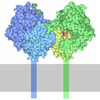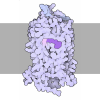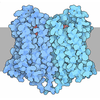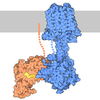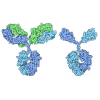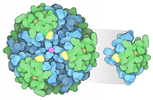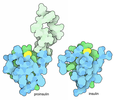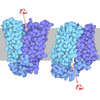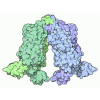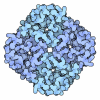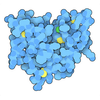+ Open data
Open data
- Basic information
Basic information
| Entry | Database: PDB / ID: 8fyt | ||||||||||||||||||
|---|---|---|---|---|---|---|---|---|---|---|---|---|---|---|---|---|---|---|---|
| Title | LSD-bound serotonin 1A (5-HT1A) receptor-Gi1 protein complex | ||||||||||||||||||
 Components Components |
| ||||||||||||||||||
 Keywords Keywords | SIGNALING PROTEIN / GPCR Signaling Complex / Serotonin Receptor | ||||||||||||||||||
| Function / homology |  Function and homology information Function and homology informationregulation of serotonin secretion / Gi/o-coupled serotonin receptor activity / regulation of hormone secretion / regulation of behavior / receptor-receptor interaction / Serotonin receptors / serotonin receptor activity / regulation of dopamine metabolic process / G protein-coupled serotonin receptor activity / serotonin receptor signaling pathway ...regulation of serotonin secretion / Gi/o-coupled serotonin receptor activity / regulation of hormone secretion / regulation of behavior / receptor-receptor interaction / Serotonin receptors / serotonin receptor activity / regulation of dopamine metabolic process / G protein-coupled serotonin receptor activity / serotonin receptor signaling pathway / serotonin metabolic process / serotonin binding / gamma-aminobutyric acid signaling pathway / exploration behavior / neurotransmitter receptor activity / G protein-coupled receptor signaling pathway, coupled to cyclic nucleotide second messenger / behavioral fear response / regulation of vasoconstriction / Adenylate cyclase inhibitory pathway / positive regulation of protein localization to cell cortex / T cell migration / D2 dopamine receptor binding / response to prostaglandin E / G protein-coupled serotonin receptor binding / adenylate cyclase-inhibiting serotonin receptor signaling pathway / adenylate cyclase regulator activity / regulation of mitotic spindle organization / cellular response to forskolin / Regulation of insulin secretion / G protein-coupled receptor binding / positive regulation of cholesterol biosynthetic process / adenylate cyclase-inhibiting G protein-coupled receptor signaling pathway / adenylate cyclase-modulating G protein-coupled receptor signaling pathway / G-protein beta/gamma-subunit complex binding / response to peptide hormone / Olfactory Signaling Pathway / Activation of the phototransduction cascade / G beta:gamma signalling through PLC beta / Presynaptic function of Kainate receptors / Thromboxane signalling through TP receptor / G protein-coupled acetylcholine receptor signaling pathway / G-protein activation / Activation of G protein gated Potassium channels / Inhibition of voltage gated Ca2+ channels via Gbeta/gamma subunits / Prostacyclin signalling through prostacyclin receptor / G beta:gamma signalling through CDC42 / Glucagon signaling in metabolic regulation / G beta:gamma signalling through BTK / Synthesis, secretion, and inactivation of Glucagon-like Peptide-1 (GLP-1) / ADP signalling through P2Y purinoceptor 12 / Sensory perception of sweet, bitter, and umami (glutamate) taste / photoreceptor disc membrane / Glucagon-type ligand receptors / Adrenaline,noradrenaline inhibits insulin secretion / Vasopressin regulates renal water homeostasis via Aquaporins / G alpha (z) signalling events / Glucagon-like Peptide-1 (GLP1) regulates insulin secretion / ADORA2B mediated anti-inflammatory cytokines production / cellular response to catecholamine stimulus / ADP signalling through P2Y purinoceptor 1 / GDP binding / G beta:gamma signalling through PI3Kgamma / adenylate cyclase-activating dopamine receptor signaling pathway / Cooperation of PDCL (PhLP1) and TRiC/CCT in G-protein beta folding / GPER1 signaling / Inactivation, recovery and regulation of the phototransduction cascade / cellular response to prostaglandin E stimulus / G-protein beta-subunit binding / heterotrimeric G-protein complex / G alpha (12/13) signalling events / sensory perception of taste / extracellular vesicle / signaling receptor complex adaptor activity / Thrombin signalling through proteinase activated receptors (PARs) / G protein activity / GTPase binding / Ca2+ pathway / retina development in camera-type eye / cell cortex / midbody / High laminar flow shear stress activates signaling by PIEZO1 and PECAM1:CDH5:KDR in endothelial cells / fibroblast proliferation / phospholipase C-activating G protein-coupled receptor signaling pathway / G alpha (i) signalling events / Hydrolases; Acting on acid anhydrides; Acting on GTP to facilitate cellular and subcellular movement / G alpha (s) signalling events / chemical synaptic transmission / G alpha (q) signalling events / Ras protein signal transduction / Extra-nuclear estrogen signaling / cell population proliferation / G protein-coupled receptor signaling pathway / lysosomal membrane / cell division / GTPase activity / centrosome / positive regulation of cell population proliferation / dendrite / synapse / protein-containing complex binding Similarity search - Function | ||||||||||||||||||
| Biological species |  Homo sapiens (human) Homo sapiens (human) | ||||||||||||||||||
| Method | ELECTRON MICROSCOPY / single particle reconstruction / cryo EM / Resolution: 2.64 Å | ||||||||||||||||||
 Authors Authors | Warren, A.L. / Zilberg, G. / Capper, M.J. / Wacker, D. | ||||||||||||||||||
| Funding support |  United States, 5items United States, 5items
| ||||||||||||||||||
 Citation Citation |  Journal: Nature / Year: 2024 Journal: Nature / Year: 2024Title: Structural pharmacology and therapeutic potential of 5-methoxytryptamines. Authors: Audrey L Warren / David Lankri / Michael J Cunningham / Inis C Serrano / Lyonna F Parise / Andrew C Kruegel / Priscilla Duggan / Gregory Zilberg / Michael J Capper / Vaclav Havel / Scott J ...Authors: Audrey L Warren / David Lankri / Michael J Cunningham / Inis C Serrano / Lyonna F Parise / Andrew C Kruegel / Priscilla Duggan / Gregory Zilberg / Michael J Capper / Vaclav Havel / Scott J Russo / Dalibor Sames / Daniel Wacker /  Abstract: Psychedelic substances such as lysergic acid diethylamide (LSD) and psilocybin show potential for the treatment of various neuropsychiatric disorders. These compounds are thought to mediate their ...Psychedelic substances such as lysergic acid diethylamide (LSD) and psilocybin show potential for the treatment of various neuropsychiatric disorders. These compounds are thought to mediate their hallucinogenic and therapeutic effects through the serotonin (5-hydroxytryptamine (5-HT)) receptor 5-HT (ref. ). However, 5-HT also plays a part in the behavioural effects of tryptamine hallucinogens, particularly 5-methoxy-N,N-dimethyltryptamine (5-MeO-DMT), a psychedelic found in the toxin of Colorado River toads. Although 5-HT is a validated therapeutic target, little is known about how psychedelics engage 5-HT and which effects are mediated by this receptor. Here we map the molecular underpinnings of 5-MeO-DMT pharmacology through five cryogenic electron microscopy (cryo-EM) structures of 5-HT, systematic medicinal chemistry, receptor mutagenesis and mouse behaviour. Structure-activity relationship analyses of 5-methoxytryptamines at both 5-HT and 5-HT enable the characterization of molecular determinants of 5-HT signalling potency, efficacy and selectivity. Moreover, we contrast the structural interactions and in vitro pharmacology of 5-MeO-DMT and analogues to the pan-serotonergic agonist LSD and clinically used 5-HT agonists. We show that a 5-HT-selective 5-MeO-DMT analogue is devoid of hallucinogenic-like effects while retaining anxiolytic-like and antidepressant-like activity in socially defeated animals. Our studies uncover molecular aspects of 5-HT-targeted psychedelics and therapeutics, which may facilitate the future development of new medications for neuropsychiatric disorders. | ||||||||||||||||||
| History |
|
- Structure visualization
Structure visualization
| Structure viewer | Molecule:  Molmil Molmil Jmol/JSmol Jmol/JSmol |
|---|
- Downloads & links
Downloads & links
- Download
Download
| PDBx/mmCIF format |  8fyt.cif.gz 8fyt.cif.gz | 189 KB | Display |  PDBx/mmCIF format PDBx/mmCIF format |
|---|---|---|---|---|
| PDB format |  pdb8fyt.ent.gz pdb8fyt.ent.gz | 139.2 KB | Display |  PDB format PDB format |
| PDBx/mmJSON format |  8fyt.json.gz 8fyt.json.gz | Tree view |  PDBx/mmJSON format PDBx/mmJSON format | |
| Others |  Other downloads Other downloads |
-Validation report
| Summary document |  8fyt_validation.pdf.gz 8fyt_validation.pdf.gz | 1.4 MB | Display |  wwPDB validaton report wwPDB validaton report |
|---|---|---|---|---|
| Full document |  8fyt_full_validation.pdf.gz 8fyt_full_validation.pdf.gz | 1.4 MB | Display | |
| Data in XML |  8fyt_validation.xml.gz 8fyt_validation.xml.gz | 41 KB | Display | |
| Data in CIF |  8fyt_validation.cif.gz 8fyt_validation.cif.gz | 60 KB | Display | |
| Arichive directory |  https://data.pdbj.org/pub/pdb/validation_reports/fy/8fyt https://data.pdbj.org/pub/pdb/validation_reports/fy/8fyt ftp://data.pdbj.org/pub/pdb/validation_reports/fy/8fyt ftp://data.pdbj.org/pub/pdb/validation_reports/fy/8fyt | HTTPS FTP |
-Related structure data
| Related structure data |  29597MC 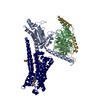 8fy8C  8fyeC  8fylC 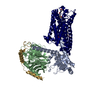 8fyxC M: map data used to model this data C: citing same article ( |
|---|---|
| Similar structure data | Similarity search - Function & homology  F&H Search F&H Search |
- Links
Links
- Assembly
Assembly
| Deposited unit | 
|
|---|---|
| 1 |
|
- Components
Components
-Protein , 1 types, 1 molecules R
| #1: Protein | Mass: 61375.930 Da / Num. of mol.: 1 / Mutation: 3 Source method: isolated from a genetically manipulated source Details: N-terminal HA signal sequence, flag-tag, his-tag, tev cleavage site followed by soluble cytochrome b562 (E. coli) and truncated 5-hydroxytryptamine receptor 1A (Homo sapiens) with a point ...Details: N-terminal HA signal sequence, flag-tag, his-tag, tev cleavage site followed by soluble cytochrome b562 (E. coli) and truncated 5-hydroxytryptamine receptor 1A (Homo sapiens) with a point mutation at position 255 in the provided sequence. This mutation is in Ballesteros-Weinstein position 3.41 of 5-HT1A where the original leucine was mutated to a tryptophan. Cytochrome b562 (cybC, UniProt P0ABE7) is both n and c-terminally truncated with two point mutations.,N-terminal HA signal sequence, flag-tag, his-tag, tev cleavage site followed by soluble cytochrome b562 (E. coli) and truncated 5-hydroxytryptamine receptor 1A (Homo sapiens) with a point mutation at position 255 in the provided sequence. This mutation is in Ballesteros-Weinstein position 3.41 of 5-HT1A where the original leucine was mutated to a tryptophan. Cytochrome b562 (cybC, UniProt P0ABE7) is both n and c-terminally truncated with two point mutations. Source: (gene. exp.)  Homo sapiens (human) / Gene: cybC, HTR1A, ADRB2RL1, ADRBRL1 / Plasmid: pFB / Production host: Homo sapiens (human) / Gene: cybC, HTR1A, ADRB2RL1, ADRBRL1 / Plasmid: pFB / Production host:  |
|---|
-Guanine nucleotide-binding protein ... , 3 types, 3 molecules ABG
| #2: Protein | Mass: 40415.031 Da / Num. of mol.: 1 Source method: isolated from a genetically manipulated source Source: (gene. exp.)  Homo sapiens (human) / Gene: GNAI1 / Production host: Homo sapiens (human) / Gene: GNAI1 / Production host:  |
|---|---|
| #3: Protein | Mass: 39418.086 Da / Num. of mol.: 1 Source method: isolated from a genetically manipulated source Details: Guanine nucleotide-binding protein G(I)/G(S)/G(T) subunit beta-1 with N-terminal his-tag and 3C cleavage site and GSSG linker Source: (gene. exp.)  Homo sapiens (human) / Gene: GNB1 / Production host: Homo sapiens (human) / Gene: GNB1 / Production host:  |
| #4: Protein | Mass: 8506.765 Da / Num. of mol.: 1 Source method: isolated from a genetically manipulated source Source: (gene. exp.)  Homo sapiens (human) / Gene: GNG2 / Production host: Homo sapiens (human) / Gene: GNG2 / Production host:  |
-Non-polymers , 3 types, 4 molecules 
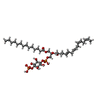



| #5: Chemical | ChemComp-7LD / ( |
|---|---|
| #6: Chemical | ChemComp-J40 / [( |
| #7: Chemical |
-Details
| Has ligand of interest | Y |
|---|---|
| Has protein modification | Y |
-Experimental details
-Experiment
| Experiment | Method: ELECTRON MICROSCOPY |
|---|---|
| EM experiment | Aggregation state: PARTICLE / 3D reconstruction method: single particle reconstruction |
- Sample preparation
Sample preparation
| Component | Name: Serotonin 1A (5-HT1A) receptor-Gi1 protein complex / Type: COMPLEX Details: Serotonin 1A (5-HT1A) receptor-Gi1 protein complex with components purified separately and assembled in vitro. Entity ID: #1-#4 / Source: RECOMBINANT | ||||||||||||||||||||||||
|---|---|---|---|---|---|---|---|---|---|---|---|---|---|---|---|---|---|---|---|---|---|---|---|---|---|
| Molecular weight | Experimental value: NO | ||||||||||||||||||||||||
| Source (natural) | Organism: Escherichia coli, Homo sapiens | ||||||||||||||||||||||||
| Source (recombinant) | Organism:  | ||||||||||||||||||||||||
| Buffer solution | pH: 7.4 | ||||||||||||||||||||||||
| Buffer component |
| ||||||||||||||||||||||||
| Specimen | Conc.: 26 mg/ml / Embedding applied: NO / Shadowing applied: NO / Staining applied: NO / Vitrification applied: YES Details: Sample was mono disperse following gel filtration. The sample was immediately concentrated for CryoEM grid preparation. | ||||||||||||||||||||||||
| Specimen support | Grid material: COPPER / Grid mesh size: 300 divisions/in. / Grid type: Quantifoil | ||||||||||||||||||||||||
| Vitrification | Instrument: LEICA EM GP / Cryogen name: ETHANE Details: Blot force 3 for 3-5 seconds was used and subsequent grids were screened for ice thickness prior to data collection. |
- Electron microscopy imaging
Electron microscopy imaging
| Experimental equipment |  Model: Titan Krios / Image courtesy: FEI Company |
|---|---|
| Microscopy | Model: FEI TITAN KRIOS |
| Electron gun | Electron source:  FIELD EMISSION GUN / Accelerating voltage: 300 kV / Illumination mode: FLOOD BEAM FIELD EMISSION GUN / Accelerating voltage: 300 kV / Illumination mode: FLOOD BEAM |
| Electron lens | Mode: BRIGHT FIELD / Nominal defocus max: 2500 nm / Nominal defocus min: 500 nm |
| Image recording | Electron dose: 53.61 e/Å2 / Film or detector model: GATAN K3 (6k x 4k) |
- Processing
Processing
| EM software |
| |||||||||||||||||||||||||||||||||
|---|---|---|---|---|---|---|---|---|---|---|---|---|---|---|---|---|---|---|---|---|---|---|---|---|---|---|---|---|---|---|---|---|---|---|
| CTF correction | Type: PHASE FLIPPING AND AMPLITUDE CORRECTION | |||||||||||||||||||||||||||||||||
| Particle selection | Num. of particles selected: 12502189 | |||||||||||||||||||||||||||||||||
| 3D reconstruction | Resolution: 2.64 Å / Resolution method: FSC 0.143 CUT-OFF / Num. of particles: 318050 Details: Refinement performed in cryoSPARC. Resolution value from refinement with a tight mask. Refinement without a mask has a resolution of 3.4A. Num. of class averages: 1 / Symmetry type: POINT | |||||||||||||||||||||||||||||||||
| Refine LS restraints |
|
 Movie
Movie Controller
Controller







 PDBj
PDBj

